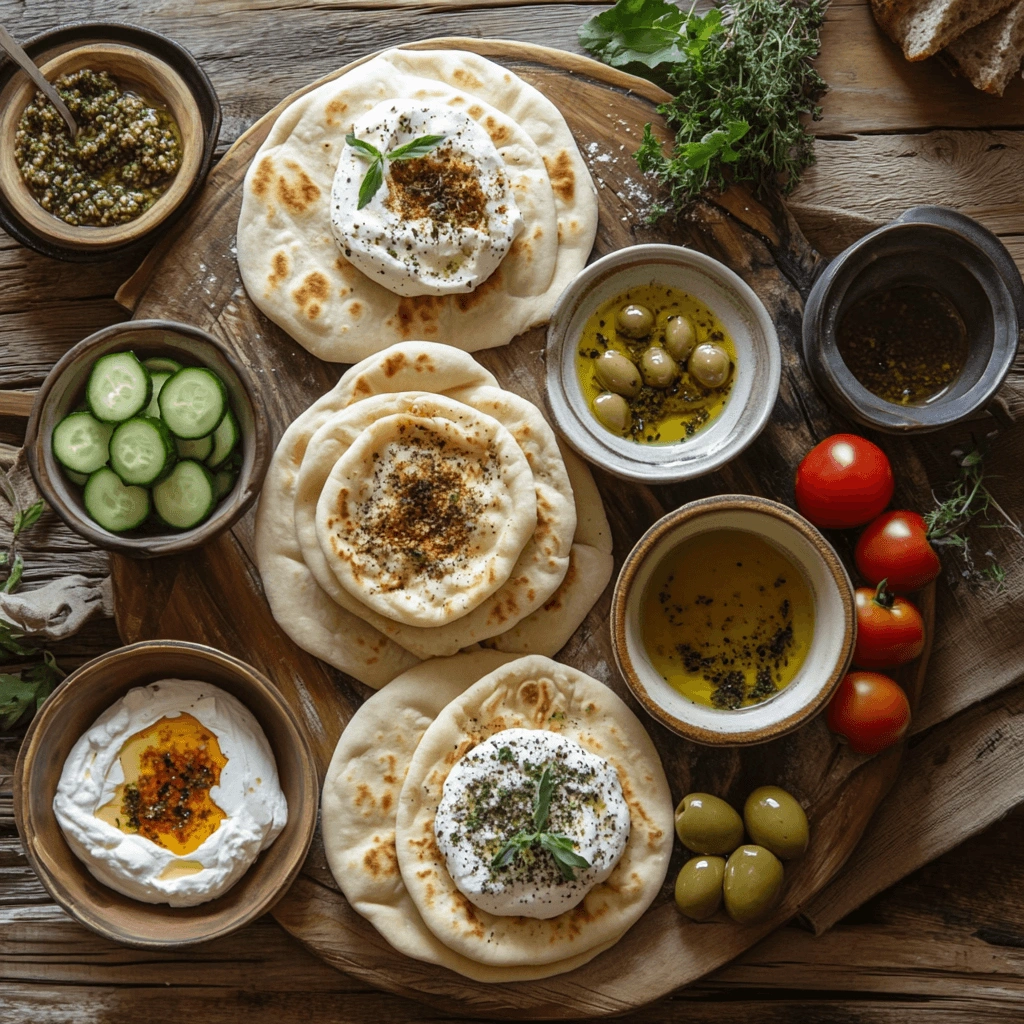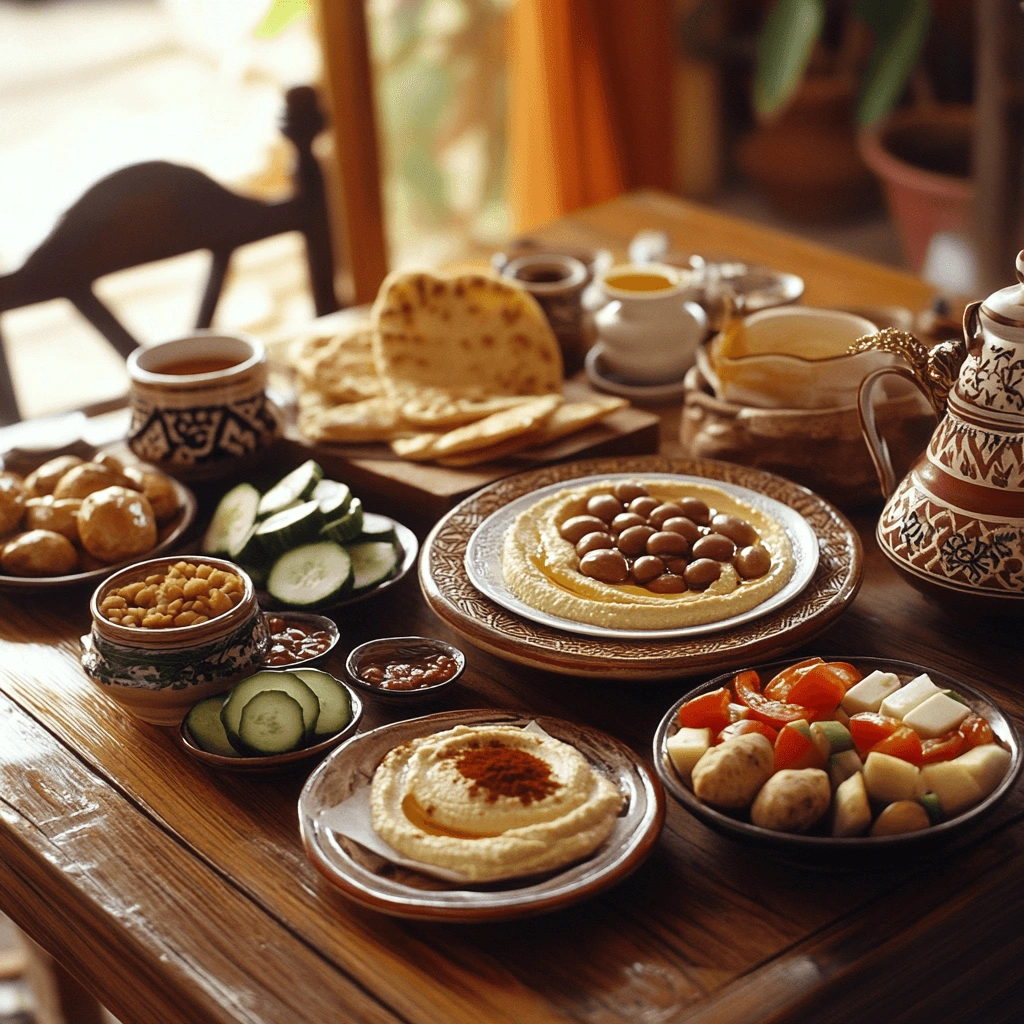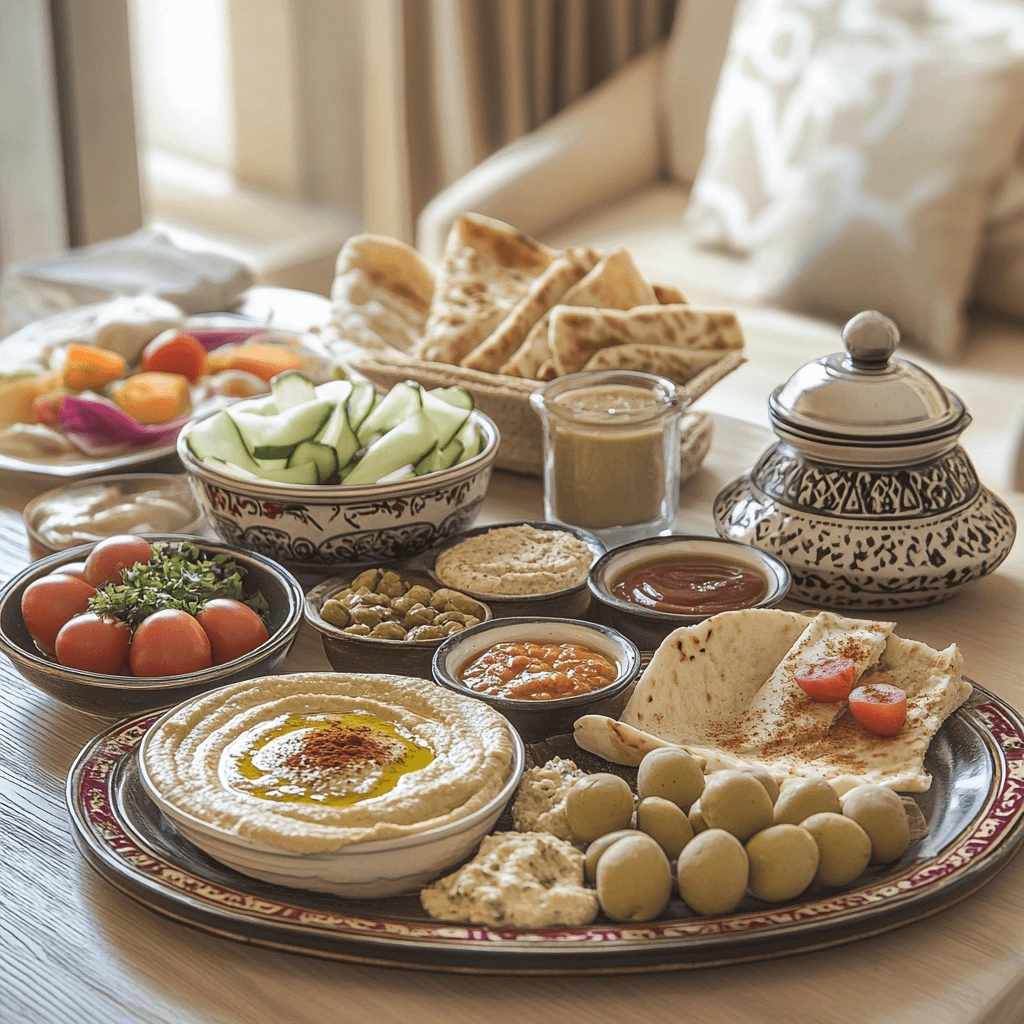Introduction
A traditional Arabic breakfast food recipes is much more than just a meal; it’s a cultural experience that unites family and friends, setting the tone for the day with vibrant flavors. In many Arab countries, breakfast isn’t just about food it’s a time to come together, exchange stories, and enjoy the bounty of fresh, wholesome ingredients that define a typical morning spread. Whether you’re exploring the bustling markets of Cairo, the peaceful hills of Lebanon, or the lively streets of Damascus, the diversity and richness of Arabic breakfast dishes provide a unique window into the region’s history, agriculture, and culinary traditions.
What makes an Arabic breakfast truly special is its perfect balance of savory, sweet, and fresh flavors that come together harmoniously. Staples like ful medames, shakshuka, hummus, and manakish are found in homes across the Middle East. These dishes combine hearty proteins, colorful vegetables, aromatic spices, and refreshing dairy to create meals that are both satisfying and nourishing. From the earthy warmth of olive oil and za’atar to the sweet richness of dates and honey, each bite delivers a depth of flavor that’s hard to replicate.
The charm of a traditional Arabic breakfast lies in its simplicity. It focuses on using fresh, high-quality ingredients that shine on their own. Whether it’s the tangy labneh, the smooth hummus, or the crispy manakish, these dishes are easy to prepare yet deeply satisfying. Furthermore, they showcase the rich cultural diversity of the Arabic world, with each country and region adding its unique twist to beloved breakfast classics.
In this article, we’ll guide you through the must-try Arabic breakfast dishes, highlight the essential pantry ingredients you need to stock up on, and share expert tips to help you create and serve an authentic spread at home. From savory staples like ful medames to the sweet indulgence of dates and honey, we’ll cover everything you need to bring the magic of a traditional Arabic breakfast into your kitchen.
Essential Ingredients for a Traditional Arabic Breakfast
Arabic breakfasts are built around simple yet flavorful ingredients, each contributing to the rich taste and cultural significance of the meal. Whether you’re making classic Arabic breakfast food recipes or creating your own variations, these key components will help you achieve an authentic Middle Eastern breakfast experience.

Olive Oil and Za’atar – Staples in Many Dishes
Olive oil is a cornerstone of Arabic cuisine, adding a rich, smooth texture to many dishes. Whether drizzled over labneh, hummus, or ful medames, or used as a dip for fresh bread, it enhances every bite.
Za’atar, a fragrant spice blend crafted from thyme, sumac, sesame seeds, and salt, is yet another essential ingredient in Arabic cuisine. Typically, it is combined with olive oil and spread over warm manakish, or generously sprinkled onto yogurt and eggs to enhance their flavor. The earthy, tangy, and subtly nutty profile of za’atar contributes to the unique taste of Arabic breakfasts, making them truly distinctive. With its rich depth of flavor, za’atar plays a key role in elevating these traditional dishes.
Labneh and Yogurt – Creamy, Tangy, and Often Paired with Bread
Labneh, a thick and creamy strained yogurt, is a popular spread for breakfast. It’s often served with olive oil, za’atar, or fresh mint, making it a versatile and healthy choice.
Plain yogurt is another staple, commonly paired with honey, nuts, or fresh fruit for a refreshing and slightly sweet start to the day. Its probiotic benefits and light texture make it a perfect addition to any Arabic breakfast spread.
Fresh Bread (Pita, Manakish, Ka’ak) – The Foundation of Arabic Breakfast
Bread is the heart of traditional Arabic breakfast food recipes. Some of the most common varieties include:
- Pita Bread – A soft, round flatbread perfect for scooping up hummus, ful medames, and labneh.
- Manakish – A Lebanese-style flatbread topped with za’atar, cheese, or minced meat, often enjoyed warm from the oven.
- Ka’ak – A sesame-crusted bread ring with a slightly crunchy exterior, typically served with cheese, olives, or sweet spreads like date syrup.
Arabic breakfast isn’t complete without warm, freshly baked bread, as it serves as the perfect base for enjoying dips, spreads, and toppings.
Dates, Honey, and Nuts – Common Sweet Additions for a Balanced Meal
Middle Eastern breakfasts often feature a delicate balance between sweet and savory flavors. For natural sweetness, many households serve:
- Dates – Rich in fiber and natural sugars, dates are often paired with Arabic coffee for a traditional touch.
- Honey – Drizzled over yogurt, labneh, or ka’ak for a light and flavorful treat.
- Almonds, Walnuts, and Pistachios – Often sprinkled over honey-drenched yogurt or eaten alongside fresh fruit for a satisfying crunch.
These ingredients provide a nutritious, energy-boosting start to the day, complementing the savory dishes commonly found in an Arabic breakfast.
Classic Arabic Breakfast Dishes You Must Try
Arabic breakfasts are known for their rich flavors, wholesome ingredients, and cultural significance. From savory fava bean dishes to flavorful flatbreads, each dish carries a unique blend of spices and textures that make breakfast a truly satisfying experience. Below are some of the most beloved Arabic breakfast food recipes that you must try.

Ful Medames – A Hearty Fava Bean Dish with Olive Oil, Garlic, and Lemon
Ful Medames is a staple breakfast dish across the Middle East and North Africa. Made from slow-cooked fava beans, this dish is seasoned with garlic, cumin, lemon juice, and extra virgin olive oil for a bold, earthy flavor.
- Serving Suggestions: Ful Medames is traditionally enjoyed with pita bread, chopped tomatoes, onions, and a drizzle of tahini sauce. Some variations include adding boiled eggs or pickled vegetables for extra flavor.
- Why It’s Popular: Packed with protein and fiber, Ful Medames is both nutritious and incredibly filling, making it a perfect way to start the day.
Shakshuka – Poached Eggs in a Spiced Tomato Sauce
Shakshuka is a flavorful and comforting dish made with eggs poached in a rich tomato sauce infused with garlic, paprika, cumin, and chili flakes. Originating in North Africa, this dish has become a beloved breakfast choice across the Arab world.
- Serving Suggestions: Shakshuka is best enjoyed with crusty bread or pita to soak up the savory, spiced tomato sauce.
- Why It’s Popular: The combination of runny eggs and aromatic tomato sauce creates a perfectly balanced meal that is both easy to prepare and deeply satisfying.
Manakish – Arabic Flatbread Topped with Za’atar, Cheese, or Meat
Manakish, often called the “pizza of the Middle East,” features a thin, oven-baked flatbread topped with a variety of savory ingredients. This makes it a versatile and delicious breakfast choice.
- Popular Toppings:
- Za’atar and Olive Oil – A traditional, aromatic blend of thyme, sesame seeds, and sumac.
- Cheese (Akkawi or Halloumi) – A rich, salty option for cheese lovers.
- Minced Meat (Lahm bi Ajeen) – A spiced meat topping that adds depth and flavor.
- Why It’s Popular: Manakish is crispy on the outside, soft on the inside, and bursting with flavor. It’s often paired with labneh, olives, or fresh vegetables for a complete meal.
Falafel and Hummus – A Protein-Packed Combination Served with Fresh Veggies
Falafel and hummus are classic Arabic breakfast staples that provide a delicious balance of protein, fiber, and flavor.
- Falafel: These deep-fried chickpea or fava bean patties are crispy on the outside and fluffy on the inside, spiced with garlic, coriander, cumin, and parsley.
- Hummus: A creamy dip made from blended chickpeas, tahini, lemon juice, and olive oil, offering a smooth, rich texture.
- Serving Suggestions: This duo is often served with pita bread, fresh cucumbers, tomatoes, pickled vegetables, and tahini sauce.
- Why It’s Popular: Falafel and hummus together create a satisfying, plant-based breakfast that’s packed with essential nutrients and bold Middle Eastern flavors.
If you’re craving the hearty warmth of Ful Medames, the spiced richness of Shakshuka, or the crispy goodness of Falafel, then these Arabic breakfast recipes are a must-try. Each dish offers a unique, irresistible flavor that will transport your taste buds straight to the heart of Arabic cuisine. Each dish offers a unique taste of the Middle East, making them perfect for anyone eager to indulge in an authentic and satisfying morning feast.
Refreshing Arabic Breakfast Beverages: Traditional Drinks to Complement Your Meal
A traditional Arabic breakfast truly comes alive with the addition of authentic Middle Eastern beverages that perfectly complement its rich and diverse flavors. From bold, spiced coffee to refreshing herbal teas and creamy yogurt drinks, these beverages not only enhance the overall experience but also infuse the meal with unique aromas and deep cultural significance. Together, they elevate the breakfast, making it a complete and memorable experience.

Arabic Coffee (Gahwa) – Strong, Spiced, and Served with Dates
Arabic coffee, or gahwa, plays a crucial role in Middle Eastern hospitality. This light-roasted coffee is expertly brewed with cardamom and, in some cases, infused with saffron or cloves, which imparts a distinctive and aromatic flavor. Typically, gahwa is served in small cups (finjans) without sugar, and it is often accompanied by sweet dates, which help balance the coffee’s natural bitterness.
How to Prepare Authentic Arabic Coffee:
- Grind lightly roasted Arabic coffee beans into a fine powder.
- Boil water with crushed cardamom pods (and saffron for a richer taste).
- Add the coffee grounds and simmer for 10–15 minutes.
- Strain and serve in small cups alongside fresh dates.
Karak Tea – A Flavorful Milk Tea Infused with Cardamom
Karak tea is a strong, spiced black tea that originated in the Gulf region and has become popular across the Middle East. It is quite similar to Indian masala chai; however, it stands out with its unique cardamom-forward flavor, giving it a distinct and aromatic twist. The tea is simmered with milk and sugar, resulting in a rich and creamy drink with a slightly sweet and spiced profile.
Simple Karak Tea Recipe:
- Brew strong black tea in hot water.
- Add crushed cardamom pods, cloves, and cinnamon for spice.
- Stir in condensed milk or evaporated milk for a creamy texture.
- Simmer for a few minutes, strain, and serve hot.
Mint Tea – A Refreshing Herbal Tea Served Warm or Cold
Mint tea is undoubtedly one of the most cherished herbal beverages in Arabic breakfast recipes. Crafted with green tea leaves and fresh mint, it offers a light, aromatic experience that is both refreshing and soothing. Often sweetened with sugar or honey, it perfectly balances sweetness with herbal freshness. As a result, it becomes the ideal companion to kick-start your day, providing a comforting and energizing boost.
How to Make Classic Mint Tea:
- Boil water and steep green tea leaves for a few minutes.
- Add fresh mint leaves and let them infuse for a richer taste.
- Sweeten with sugar or honey, depending on preference.
- Serve hot in small glasses or let it cool and enjoy iced.
Ayran (Yogurt Drink) – A Tangy, Cooling Yogurt-Based Drink
Ayran is a refreshing, salty yogurt drink that is a staple in Middle Eastern breakfasts. It pairs exceptionally well with savory dishes like falafel, hummus, and manakish, helping to balance out spicy or heavy flavors. You make Ayran by mixing yogurt, water, and a pinch of salt, creating a light, probiotic-rich beverage that aids digestion.
Quick Ayran Recipe:
- Whisk plain yogurt with chilled water until smooth.
- Add a pinch of salt for a traditional taste.
- Blend until frothy and serve cold, optionally garnished with fresh mint.
Enjoying the Perfect Beverage with Your Arabic Breakfast
Each of these drinks adds a unique element to Arabic breakfast food recipes, enhancing the meal with bold, creamy, refreshing, or cooling flavors. Whether you prefer the strong aroma of Arabic coffee, the rich creaminess of Karak tea, the light freshness of mint tea, or the probiotic goodness of Ayran, these beverages bring authentic Middle Eastern flavors to your morning routine.
How to Assemble a Perfect Arabic Breakfast Spread
A traditional Arabic breakfast spread is not just about the food—it’s about balance, presentation, and variety. The meal typically includes a mix of savory, sweet, and tangy flavors, all served with fresh bread and delicious accompaniments. Whether you’re hosting a Middle Eastern-inspired brunch or simply want to enjoy an authentic morning meal, here’s how to create the perfect spread.

Balancing Flavors – Mixing Savory, Sweet, and Tangy Components
A well-rounded Arabic breakfast table includes a variety of flavors and textures to satisfy every palate. Here’s how to achieve the perfect balance:
- Savory Elements: These form the heart of the meal. Ful medames, shakshuka, hummus, and falafel are classic options that bring rich, earthy flavors.
- Sweet Additions: Balance the meal with dates, honey, fruit jams, and Arabic pastries like ma’amoul or qatayef.
- Tangy Components: To enhance the contrast, include labneh (strained yogurt), pickled vegetables, and za’atar with olive oil. The tanginess of these ingredients complements both sweet and savory dishes.
By offering a variety of dishes, you allow guests to mix and match flavors for a unique and satisfying experience.
Serving Suggestions – Arranging Dips, Bread, and Proteins Attractively
Presentation is key when serving Arabic breakfast food recipes. Middle Eastern breakfasts often feature a mezze-style arrangement, with small plates placed at the center of the table for sharing. Follow these tips for an inviting setup:
- Use a Large Serving Platter: Place small bowls of hummus, labneh, and baba ganoush around the edges, with fresh bread in the center.
- Serve Bread in a Basket: Arrange pita bread, manakish, or ka’ak neatly in a woven basket to keep it warm and accessible.
- Add a Colorful Touch: Use chopped tomatoes, cucumbers, and pomegranate seeds to add vibrancy and freshness to the spread.
- Keep Proteins in Small Portions: Offer falafel, boiled eggs, or grilled halloumi cheese in bite-sized servings for easy eating.
This arrangement not only enhances the visual appeal but also makes the meal feel more inviting and communal.
Traditional Table Setting – How Arabic Breakfasts Are Presented
In many Arabic households, breakfast is a shared experience, often served on a low dining table or floor seating with cushions for comfort. Here’s how to set up your breakfast table authentically:
- Use Decorative Tableware: Opt for ceramic or wooden serving dishes with intricate Middle Eastern designs.
- Offer Tea and Coffee in Elegant Cups: Arabic coffee is traditionally served in small, handle-less cups, while mint tea is poured from a long-spouted teapot into glass cups.
- Arrange Seating for Sharing: Many families sit together on floor cushions or around a communal table, emphasizing the social aspect of the meal.
If you want to replicate this at home, consider using a round table or a large wooden tray to create a cozy, welcoming setting.
Accompaniments – Olives, Fresh Vegetables, and Pickles for Extra Flavor
No Arabic breakfast spread is complete without a selection of flavorful sides that add depth to the meal. Here are some must-have accompaniments:
- Olives: Green and black olives, often marinated in olive oil and spices, provide a briny contrast to creamy dips.
- Fresh Vegetables: Chopped cucumbers, tomatoes, radishes, and fresh mint bring a refreshing crunch to the meal.
- Pickled Vegetables: Tangy pickled turnips, peppers, and carrots add a delightful contrast to rich and creamy dishes.
These sides not only enhance the flavor profile of your meal but also add vibrant colors to your breakfast table.
By carefully curating a diverse selection of dishes, breads, and sides, you can create a traditional Arabic breakfast experience that’s both delicious and visually stunning. Whether you’re preparing a meal for family or hosting a brunch, this guide ensures your spread is authentic, balanced, and memorable.
Tips for Making an Authentic Arabic Breakfast at Home
To create a truly authentic Arabic breakfast, you need more than just following recipes; it’s about understanding the flavors, selecting the right ingredients, and mastering traditional techniques. Whether you’re assembling a simple mezze-style spread or preparing a hearty meal, these essential tips will guide you in achieving an authentic Middle Eastern breakfast experience.

Use Fresh, Quality Ingredients – Essential for Authentic Taste
The key to a delicious Arabic breakfast starts with high-quality, fresh ingredients. Since many Middle Eastern dishes are simple, the ingredients themselves must shine. Here are a few essentials to prioritize:
- Olive Oil – Use extra virgin olive oil for dipping bread, drizzling over hummus, and enhancing labneh.
- Fresh Herbs – Mint, parsley, and cilantro add brightness to salads and dips.
- Authentic Spices – Sumac, za’atar, cumin, and cardamom bring depth and warmth to your dishes.
- Locally Sourced Dairy – Fresh labneh, Akkawi cheese, and halloumi make a difference in both taste and texture.
- Quality Bread – Soft, pillowy pita or freshly baked manakish completes the meal.
Mastering Simple Cooking Techniques – Frying, Baking, and Blending
Traditional Arabic breakfast food recipes often rely on basic yet effective cooking techniques. Learning these simple methods will help you elevate your dishes and achieve an authentic flavor.
- Frying – Many dishes, like falafel and eggs with sujuk (spiced sausage), require frying for crispy textures. Always use neutral oil or olive oil for best results.
- Baking – Manakish, ka’ak, and other traditional bread-based dishes are best when baked fresh. A hot oven or taboon (clay oven) is ideal for achieving the perfect crust.
- Blending – Many breakfast dips like hummus, baba ganoush, and tahini sauce require blending to create a smooth, creamy consistency. Using a high-quality blender or food processor is key.
Preparing in Advance – Making Dips and Bread Ahead of Time
To make your Arabic breakfast experience smooth and stress-free, prep some elements the night before. Many components taste even better after resting, as the flavors have time to develop.
- Hummus and Baba Ganoush – These can be made a day ahead and stored in the fridge.
- :
- Pickled Vegetables : Arabic breakfasts often include tangy pickled cucumbers, turnips, or olives, which are best made in advance.
- Pita and Manakish Dough : Preparing and refrigerating dough ahead of time allows you to quickly bake fresh bread in the morning.
Experimenting with Flavors – Customizing Dishes to Personal Taste
Traditional Arabic breakfast recipes feature time-honored flavors, but you can easily get creative and customize dishes to suit your taste.
- Enhance Labneh – Try mixing in roasted garlic, honey, or chili flakes for a unique twist.
- Upgrade Your Shakshuka – Experiment with different toppings like feta cheese, spicy harissa, or sautéed spinach.
- Spice Up Ful Medames – Add a dollop of tahini, chili oil, or extra lemon juice for a fresh take.
- Sweet and Savory Pairings – Serve dates with cheese and nuts, or drizzle honey over manakish for a mix of flavors.
By following these tips, you can bring the essence of an authentic Arabic breakfast into your home while adapting it to your personal preferences. These techniques guarantee a delicious, traditional experience every time, whether you’re making a mezze spread or a full breakfast feast.
Conclusion:
A traditional Arabic breakfast is much more than a meal; it provides a beautiful glimpse into Middle Eastern culture and hospitality. For instance, dishes like the hearty ful medames, spicy yet savory shakshuka, and comforting hummus and labneh effortlessly combine, creating a harmonious blend of flavors and ingredients. These dishes are not only deeply satisfying but also packed with nutritional benefits. The fresh bread, rich olive oil, and perfectly balanced herbs and spices come together to offer a nourishing breakfast experience.
Arabic breakfast recipes not only taste delicious but also carry a rich history, tradition, and the spirit of family gatherings. Sharing a morning meal with loved ones or preparing an authentic spread will foster a memorable, warm, and generous experience.
If you haven’t yet tried making an Arabic breakfast at home, now is the perfect time! These dishes are simple to prepare, and the ingredients are easy to find. Recreating vibrant Middle Eastern flavors in your kitchen is straightforward, and sharing these meals with loved ones is truly rewarding.
We’d love to hear about your experiences with Arabic breakfast recipes! Have you made any of these dishes before? What’s your favorite Arabic breakfast dish, or is there a new recipe you’re excited to try? Share your thoughts, recipes, and experiences in the comments below. Let’s continue the conversation and celebrate the rich world of Middle Eastern breakfasts together!


1 thought on “How To Make A Traditional Arabic Breakfast: Recipes And Tips”
Comments are closed.